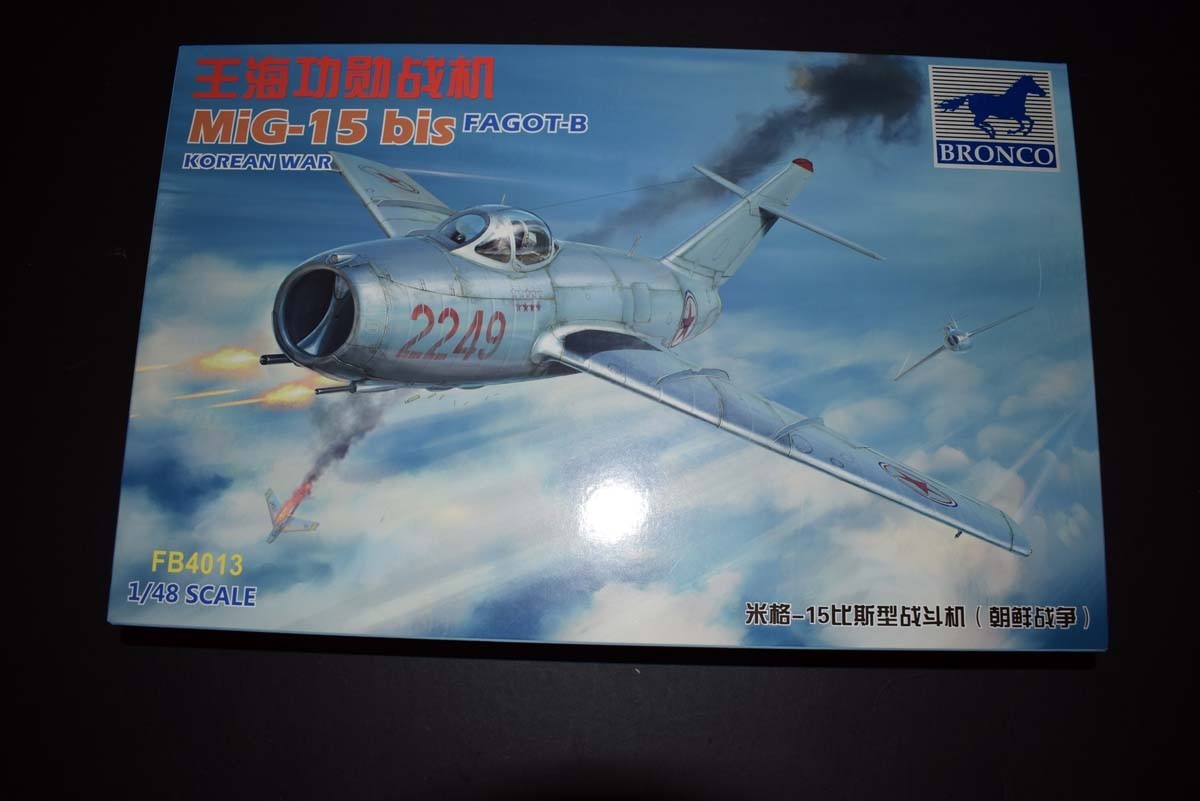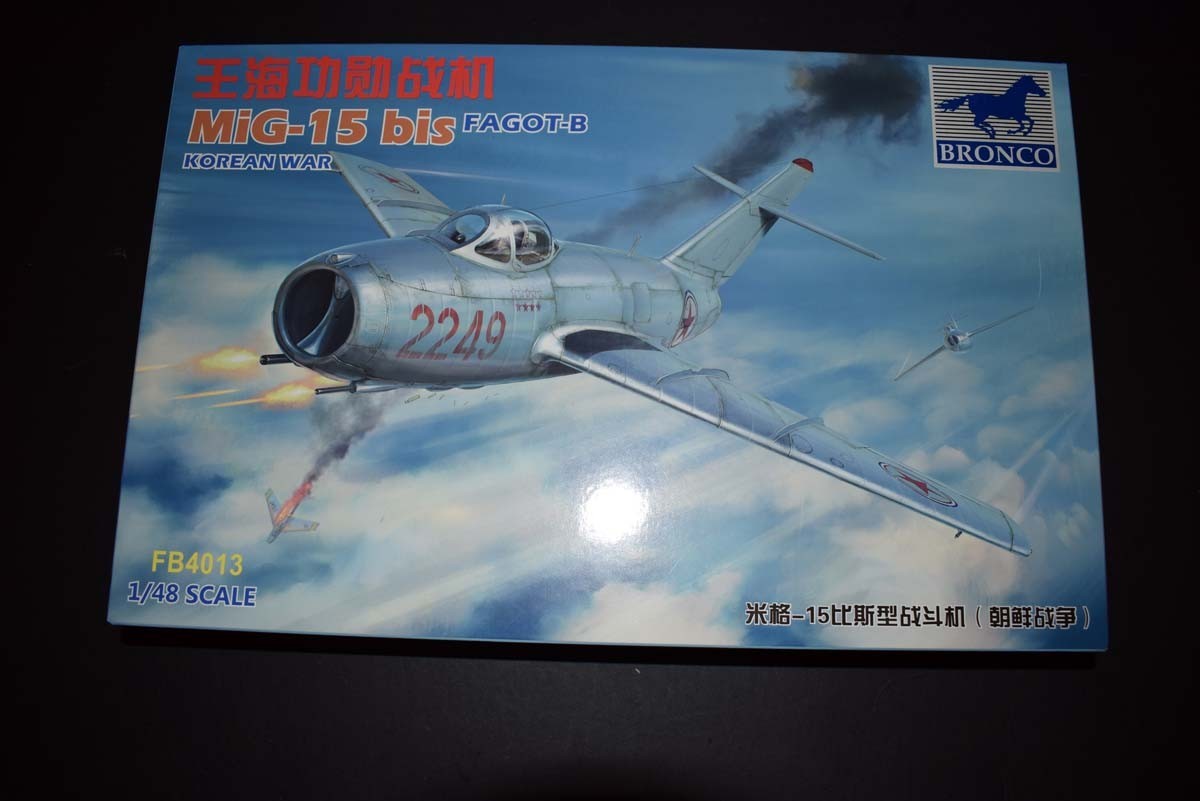Introduction
The following introduction is as provided by Bronco Models:
The Mig 15 is the first swept wing jet fighter produced by the former Soviet Union and the world’s first practical jet fighter. In March 1946, the former Soviet Union government instructed the major aircraft design bureaus to develop a light, highly manoeuvrable, high sub-sonic jet fighter. To this end Mikoyan Design Bureau selected a newly designed jet engine and adopted a swept back wing layout to successfully design the Mig 15 aircraft. NATO gave the nickname Falcon, perhaps because it shares the same name Falcon with the West (Falcon between the same name and the West)for many aircraft and later changed to the derogatory name Fagot. On December30th 1947 the newly designed prototype took off for the first time, codenamed -310. After flight testing and modification, the new aircraft was put into mass production in August 1948 and named Mig 15. In October of the same year, the aircraft began to equip troops.
On May 20th1949 the politburo of the Soviet Union decided to cancel the production plans for jet aircraft, such as the, La-15, Yak -17 and Yak -23, and fully develop Mig 15 aircraft. By 1956 more than 17,000 aircraft had been produced. The PLA Air Force began to equip Mig 15 aircraft at the end of 1950. During the Korean War, young pilots of the Chinese People’s Volunteer Air Force flew Mig 15aircraft in the skies of North Korea, shocking the world. Western military experts also have to admit that the Mig 15 is a fighter with excellent manoeuvrability. In the homeland air defence operations the People’s Air Force used the Mig 15aircraft to shoot down the US Air Forces B-19, PB-4Y, F4U, PBM-5A and the Kuomintang Air Force’s F-47, P-2V and other invading aircraft. The Mig 15 No 08aircraft is on display at the China Aviation Museum, was once piloted by Li Han. It was the first record for the volunteer aircraft to damage and shootdown US Air Force jet fighters during the anti-US aide Korea. Zhao Bartong flew a Mig 15 (Unit 25), in the North Korean air battle, and shot down or damaged 9enemy aircraft. He was the only 1st class combat hero to have won special merits twice. The aircraft they used are typical weapons in major battles in history and are important national cultural relics.
Bronco Models has released two models of the Mig15 Fagot with a B version also available in 1/48th scale. The differences between the two aircraft are minimal, and what is said in this review is fundamentally applicable to both.

Review
This offering from Bronco Models in 1/48th scale, is provided in a cardboard tray with separate card lid, the card lid having the artwork for the model on it. Inside the parts arrive in a single plastic bag, with the decals in their own bag, and you are presented with an instruction sheet rather than a booklet.
The Cockpit
The cockpit is replicated in tub form, with good detail on the two sides. I would however, suggest that painting of the sides is considered prior to assembly, in order to be able to access the detail easily. The instrument panel is provided with a decal to replicate the detail, however I am sure that photo etch offerings will be available in time. The seat in the model has good ribbing detail on the rear, but disappointingly no harness detail has been provided. Bronco Models has a reputation for producing highly detailed models, with high numbers on intricate parts, that is not the case with this release. As while detail in this area is fair, the intricacies have been extremely simplified. I do appreciate that some effort has been put into painting during the building process, and that the amount of weight required to prevent a tail sitter is covered. The other internal detail basically consists of, a reasonable length of jet exhaust, but I would have liked to have seen the intake detail go further back.
Fuselage
The fuselage halves have very nicely recessed panel line detail, which provide none of the extreme sometimes seen in models. On the interior there are very large locating lugs, which should make the two halves easier to align, and I am very impressed that Bronco managed to mould these large lugs without causing sink marks on the exterior surfaces of the model. Placement of the cockpit inside the fuselage will require some thought as the two lugs that locate it are small in size and only one on each side. The canopy glass is nicely moulded, being of a reasonable thickness and so avoiding the issues of magnification that can sometime occur. I also appreciate that the canopy can be assembled open or closed, but I do feel that extra detail will need to be added to the cockpit should you wish to assemble it open.
Flight Surfaces
The wings and tail share the same nicely recessed panel lines as the fuselage, and so should look good once painted. The airflow vanes are separate pieces that will require the modeller to ensure a good fit to the wing surfaces. The connection point of the wings uses the very large locater pins and again Bronco Models have prevented any deformation of the outer surfaces. The flight control surfaces of the wings and the vertical portion of the tail are provided as separate pieces, and so can be assembled as the modeller desires.
Undercarriage
Bronco Models has covered the installation of the undercarriage both deployed and retracted. I have to say that the undercarriage is an area of the model that I am a little disappointed in, as I feel that it is over simplified. The nose wheel is a single moulding which I find unacceptable in this scale. The wing wheels are made up of the leg, the wheel and the two doors. And while the detail here is superior to the nose, I still cannot help thinking that it is not of the usual standard I expect from Bronco Models. Bronco does provide two forms of drop tank, for this kit with the modeller free to decide which they use, or for that matter, not use at all as it does require holes to be opened in the wings for their installation, and no drill sizes have been provided.
Finishing Options
Bronco Models has provided a single finishing option for this model, which is Mig 15, 079, First Flying Group, 9th Regiment, 3rd Fighter Aviation Division Piloted by Wang Hai during the Korean War in 1951. This aircraft is displayed in the Chinese People’s Revolution Military Museum. There are a number of photographs of this particular Mig in China, unfortunately it has now been elevated for display and so limited views of it are possible. With that said, it is displayed with drop tanks and the drop tank style fitted is covered in the model.
Conclusion
These two releases from Bronco Models are a mixed blessing, In that Bronco models reputation for producing kits with an extremely high parts count, has not been replicated here, and so we get models that can easily be built by anyone, regardless of skill level. No photo etch is utilised, and so this further increases the build ability of these kits. Looking at the detail, I find the wheels to be less detailed than I would expect in a model of this scale. However, in all other respects I am pleased with the exception of the lack of harness detail. I do find myself thinking that this would be best displayed as in flight with retracted undercarriage.
Alternate Offerings
Alternate Offerings

